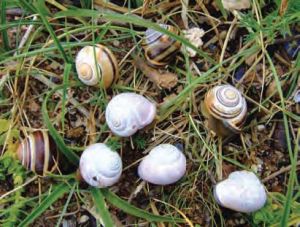|
Amanda Millar (Mollusc World 10, p. 17, March 2006) asks how long the periostracum lasts after the death of the snail. Her experiments, designed to test the assumption that dead shells that retain the periostracum must be fresh, showed that over 3 years after death, some shells retained most of their periostracum, although others had lost it completely. A few years ago, when I rediscovered Candidula gigaxii at its only Scottish site near North Berwick, I sent some apparently fresh shells to Michael Kerney, who confirmed that they were indeed C. gigaxii. However, he added, he had seen fossil shells with their markings still clear, and it would be difficult to be certain whether these were in fact fresh shells, or could date from many years ago. Knowing virtually nothing about fossil shells, I was surprised at this, especially as I was used to seeing live snails that had lost their periostracum. On the East Lothian coast, where I live, Cornu aspersum and Cepaea nemoralis are common, and a fair proportion of these have lost all or part of their periostracum (Figure 1), although still alive. It therefore seemed a reasonable assumption that the periostracum would be lost rapidly after death. In fact, coastal sites are probably particularly good places for snails to lose their periostracum rapidly. I cannot recall seeing Cornu aspersum or Cepaea spp. at inland sites that have lost their periostracum, or not at such a high frequency (though I’m open to correction on this point). My guess is that, on the coast, blowing sand rapidly wears away the periostracum; in which case, why do some snails remain unaffected? Could it be some genetic or behavioural difference, or simply that some snails are older than others, and have had much longer to become abraded? I have tried to think of other species that might lose their periostracum in life. A third species of snail that is common on the East Lothian coast is Candidula intersecta, but most of the shells one finds are empty (and weathered), so it is difficult to form a view on whether they lose the periostracum in life. Sometimes Clausilia bidentata (and presumably other clausiliids that do not occur in Scotland) can be found that have lost their periostracum, and appear pale grey instead of rich dark red. Of course, they do not live in habitats where there are likely to be abraded by sand, and other factors must be at work here. Otherwise, most species seem to keep their periostracum intact during their lives. Incidentally, I returned to the site where I had found C. gigaxii, and easily found live specimens. As a result, I learnt the important point that one needs to find live snails, and not just shells (however fresh they may look) to establish the continued presence of a species in a particular area. |
|
Loss of periostracum in living snails
Issue
12
Page
15

 Figure 1. Live specimens of Cepaea nemoralis from the Tyne Estuary at Tyninghame, East Lothian, some of which have completely lost the periostracum, while it is intact on other shells.
Figure 1. Live specimens of Cepaea nemoralis from the Tyne Estuary at Tyninghame, East Lothian, some of which have completely lost the periostracum, while it is intact on other shells.